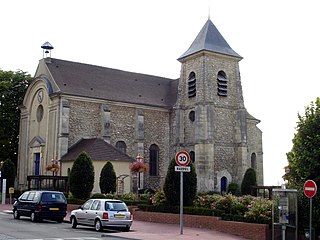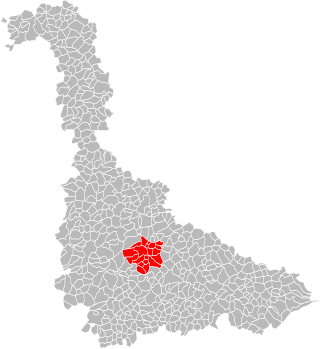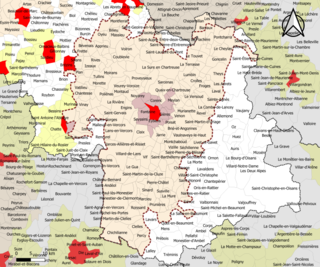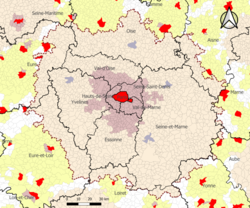
Pantin is a commune in the northeastern suburbs of Paris, Île-de-France, France. It is located 6.4 km (4.0 mi) from the centre of Paris. In 2019 its population was estimated to be 59,846. Pantin is located on the edge of the city of Paris and is mainly formed by a plain crossed by national roadway 2 and 3, the Paris–Strasbourg railway line and the canal de l'Ourcq.

An aire urbaine is an INSEE statistical concept describing a core of urban development and the extent of its commuter activity. It was replaced by the concept "functional area", which uses the same definition as Eurostat's functional urban areas, in 2020.

The city of Paris had a population of 2,165,423 people within its administrative city limits as of January 1, 2019. It is surrounded by the Paris unité urbaine, or urban area, the most populous urban area in the European Union. In 2018 the unité urbaine had a population of 10,816,803 in 2,854 km2 (1,102 sq mi). The Paris Region, or Île-de-France, covers 12,012 km2 (4,638 sq mi), and has its own regional council and president. It has a population of 12,213,447 as of January 2018, or 18.3 percent of the population of France. The metropolitan or functional area of Paris covers 18,941 km2 (7,313 sq mi) and has 13,064,617 inhabitants (2018).

The Nantes Metropolis is the métropole, an intercommunal structure, centred on the city of Nantes. It is located in the Loire-Atlantique department, in the Pays de la Loire region, western France. It was created in January 2015, replacing the previous Communauté urbaine de Nantes. Its area is 523.4 km2. Its population was 636,013 in 2018, of which 314,138 in Nantes proper.

Toulouse Métropole is one of 20 French metropolises, an intercommunal structure, centred on the city of Toulouse. Located in the Haute-Garonne department, in the Occitanie region, southern France. Created in January 2015, it replaced the previous Communauté urbaine de Toulouse. With an area of 458.2 km2, and a population of 783,353 in 2018, of which 486,828 are in Toulouse proper. It is the 5th largest metropolis after Greater Paris, Aix-Marseille-Provence, Lille-Europe and Bordeaux. The annual budget is €1,4 billion (2015).

Le Kremlin-Bicêtre is a commune in the southern suburbs of Paris, France. It is 4.5 km (2.8 mi) from the center of Paris. It is one of the most densely populated municipalities in Europe.

In France, an urban unit is a statistical area defined by INSEE, the French national statistics office, for the measurement of contiguously built-up areas. According to the INSEE definition, an "unité urbaine" is a commune alone or a grouping of communes which: a) form a single unbroken spread of urban development, with no distance between habitations greater than 200 m and b) have all together a population greater than 2,000 inhabitants. Communes not belonging to an unité urbaine are considered rural.

Saint-Galmier is a city in eastern France. It is a commune in Loire department, and belongs to the arrondissement of Montbrison. Saint-Galmier covers an area of 19.5 square kilometers. As of January 2021, it had a population of 5,842.

Nice metropolitan area as defined by INSEE in 2021 is the functional urban area or commuting zone of the city of Nice, southeastern France. It covers 100 communes, has 1,103,527 inhabitants (2021) and an area of 2,073 km2. It partly overlaps with the urban unit of Nice, which covers some cities, e.g. Antibes, Grasse and Cannes, that are part of the functional area Cannes-Antibes.

Chambon is a commune in the Cher department in the Centre-Val de Loire region of France.

Marcilly-sur-Tille is a commune in the Côte-d'Or department in eastern France.
Talasani is a rural commune and village on the eastern seaboard of Corsica, in the Haute-Corse department of France. The area has a very low population density and mainly comprises forests and farmland. As a coastal municipality, Talasani enforces strict urban planning provisions in order to preserve the ecological balance of the coast.
Champvoisy is a commune in the Marne department in north-eastern France. It is a rural municipality, with a very low population density. The municipality is part of the functional area of Reims, which is composed of 294 municipalities.

Bonneuil-en-France is a commune in the Val-d'Oise department in Île-de-France in northern France.
Pomps is a commune in the Pyrénées-Atlantiques département in south-western France.

Métropole du Grand Nancy is the métropole, an intercommunal structure, centred on the city of Nancy. It is located in the Meurthe-et-Moselle department, in the Grand Est region, northeastern France. It was created in July 2016, replacing the previous Communauté urbaine du Grand Nancy. Its area is 142.3 km2. Its population was 257,431 in 2018, of which 104,885 in Nancy proper.

Sarkozy's renovation of Paris, also known as the Grand Paris, is a vast public works programme commissioned by French president Nicolas Sarkozy between 2016 and 2030.

Grenoble metropolitan area as defined by INSEE in 2020 is the functional urban area of the city of Grenoble, southeastern France. It covers 204 communes, all in the Isère department. It has 714,799 inhabitants (2018) in an area of 2,876 km2 (1,110 sq mi), which is 39% of the Isère department. Grenoble and 15 other communes form the pôle urbain or urban cluster, the other 188 communes form the couronne or commuter belt. The most populous communes in the functional area are Grenoble, Échirolles, Fontaine, Meylan, Le Pont-de-Claix, Saint-Égrève, Saint-Martin-d'Hères, Sassenage, Seyssinet-Pariset and Voiron, all except Voiron part of the pôle urbain. It is the 11th-most populous functional urban area in France.

Cherbourg-en-Cotentin is a port city in the department of Manche, Normandy, northwestern France, established on 1 January 2016. The commune takes its name from Cherbourg, the main town of the commune, and the Cotentin Peninsula. Cherbourg is an important commercial, ferry and military port on the English Channel. Cherbourg-en-Cotentin is a Maritime prefecture and sub-prefecture of Manche. Due to its union, it is the most populous commune in its department with 79,144 inhabitants as of 2018, making it the first city of the department before the Saint-Lô prefecture and the second in the region after Caen. Its urban unit is composed of three communes, and has 81,963 inhabitants (2018). Its larger functional area has 152,630 inhabitants (2018).

An aire d'attraction d'une ville is a statistical area used by France's national statistics office INSEE since 2020, officially translated as functional area in English by INSEE, which consists of a densely populated urban agglomeration and the surrounding exurbs, towns and intervening rural areas that are socioeconomically tied to the central urban agglomeration, as measured by commuting patterns. INSEE's functional area (AAV) is therefore akin to what is most often called metropolitan area in English.




















